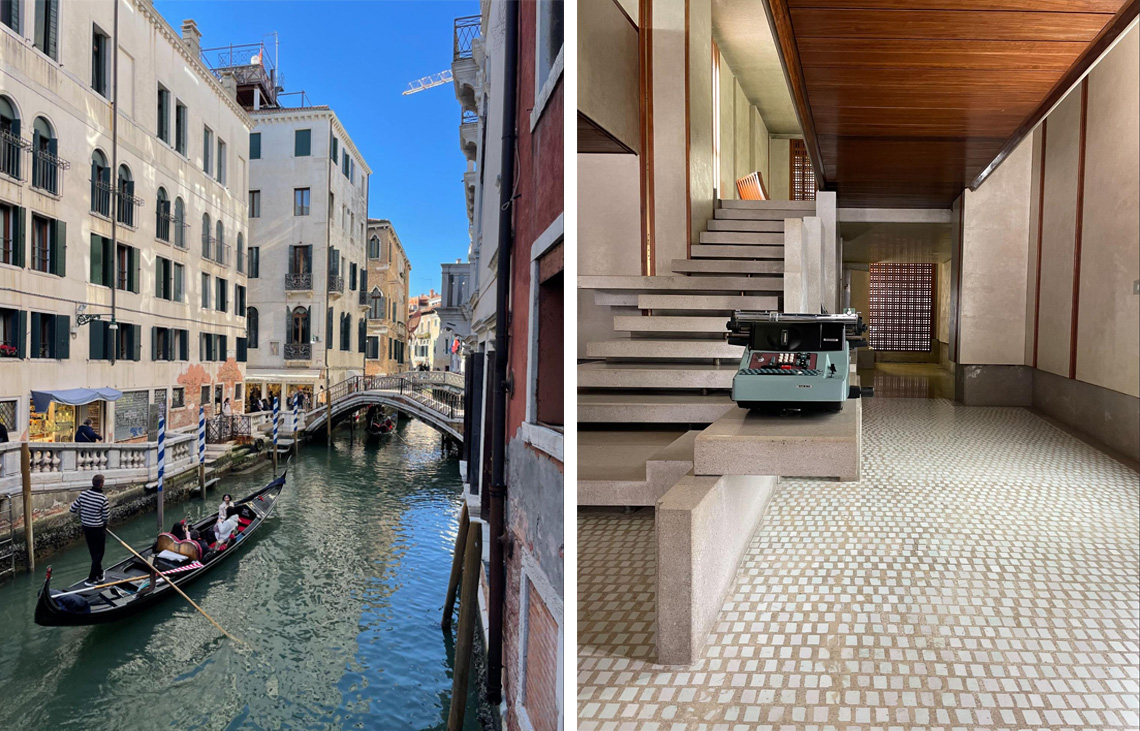"Within the program of programs of study of the UniversityMaster's Degree in Theory and Architectural design , we have considered traveling to certain cities, inside and outside Spain, to learn about their architecture and history. From April 1 to 5, the members of class of Master's Degree, traveled to Venice (Italy), where we enjoyed the city and its surroundings, but mainly the works of great architects such as Carlo Scarpa, Alvaro Siza, Aldo Rossi and Gino Valle.
Getting to know Venice, with its past and splendor, was an unforgettable experience. It was impressive to see its canals, historical buildings, squares, etc. Architectural works that have made our perception of architecture more sensitive and allowed us to see with a different look the way it is made. Even more so when this trip was guided by a professor, with a wealth of knowledge, which has explained in detail each work and corner of the city. Thank you, Esperanza Marrodán, it was a pleasure to share and learn with you.
The point of meeting and stay was Treviso, a small and charming city, which like Venice is characterized by its canals. Every night we toured this city and tasted the Italian food, with its pizzas, pastas and the Apperol Spritz, sharing moments with the whole group, which made the trip pleasant and which are also part of the experience of getting to know other cultures.
The first city we visited was Verona, which is located 120 km from Venice, and is well known for the Arena of Verona, the eighth largest amphitheater of the Roman Empire and the fourth largest in Italy, as well as being the city that inspired Shakespeare to write his famous play 'Romeo and Juliet'. The city also has a castle called Castelvecchio, which was built in the 14th century, adapted as a museum in 1924 and renovated between 1958 and 1974 by Carlo Scarpa, an Italian architect, who was always in search of perfection in architectural details.
In this Building we had a close look at Scarpa's work and with Esperanza's explanation we were able to better understand the work of this great architect. The delicacy and precision with which he worked every detail surprised us all, besides the fact that every intention in his work had a reason for being, which helps us as architects to better understand architecture, having a more critical and analytical point of view.
The next day, we went to Venice, a city built on an archipelago of more than 100 islands and divided into 6 districts. We visited some of these districts where we appreciated more of Scarpa's works, such as the Querini Stampalia Museum and the Olivetti store, analyzing once again the details and materials he used. We walked the streets of Venice and bordered the rivers that cross it, connected by pedestrian bridges, watching the coming and going of the gondolas that cross its canals. Something that caught our attention is that this city has a public transportation system that is fluvial and that efficiently connects the different places in Venice, leaving its internal streets purely pedestrian, with stores, restaurants and squares that invite you to walk around and enjoy its charm.

On the left the Venice Canals and on the right the Olivetti Shop.
One of the districts we visited was Dorsoduro, specifically on the island of Giudecca, where we saw several works of renowned architects, such as Aldo Rossi, Alvaro Siza and Gino Valle, with their residential buildings of social interest, with an architecture adapted to the historical context of the place, as well as a concern for the use of public space, especially that of Gino Valle, which has a set of voids that create spaces for socialization also giving light and air flow to the different apartments.
On this island there is also a permanent exhibition of the pavilions that were made for the 2018 Biennial, with the participation - for the first time - of the Vatican, with the theme of creating a chapel with two elements: a place for the reading of the scriptures and an altar for the Eucharist. For this work, the Vatican invited 10 architects, including Norman Foster and Eduardo Souto de Moura, where each one expressed through a different concept a place with a suitable environment for meditation and meeting with God.

On the left the Norman Foster Pavilion and on the right the Gino Valle residential building.
This trip gave us the opportunity to get to know the architecture and cultural richness of the cities we visited, their great architects, with their emblematic works, that just by seeing them up close we appreciate every detail of how they conceived their projects and how they work once materialized.
The trip ends, but we are left with a premise that is the importance for an architect to travel and enter other worlds to learn about their architecture and learn from the idiosyncrasies of each culture. It is a fundamental process in learning, whether you are an undergraduate, a graduate or a professional".
Here you can see the photo gallery made by student Iván Zúñiga:

Text written by: Iván Zúñiga González, MtDA student.